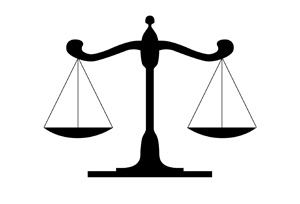CHECK UP FROM THE NECK UP
How you think about money is an enormous factor in determining the success of your money decisions. We’ve identified key steps to the mindset that will help you make good money choices.
STEPS TO THE RIGHT MINDSET
STEP 1: WATCH OUT FOR THE FINANCIAL RED LINE
Imagine a thin red line. Above the line is wealth that will allow you to meet your future goals. Below the line is debt. When you make decisions you want to be aware of this line and be careful not to get too far in debt. The overall goal for a sound financial situation is to build your wealth. Wealth means assets, things that have financial value like good investments, savings, equity in a house, and a retirement account, to name a few. Debts (or liabilities) reduce wealth because you will have to pay back debts instead of meeting your own future goals. That being said, sometimes it is necessary to go into debt in order to build wealth. For example, going into a reasonable amount of debt to pay for an education can eventually lead to a better paying job and the opportunity for wealth creation. Going into debt for a loan to buy a house (a mortgage) can result in wealth in the form of equity when you pay off the loan and/or the value of the house increases. But taking on too much debt even for good purposes can lead to long-term financial trouble.
The key is to not go too far into debt or you may not have the ability to create personal wealth. We’d like to be clear that the idea of the thin red line is not a way to look at your whole life. It’s just a useful way to look at your financial decisions. You can follow your passion, your calling, but if you have too much debt, you may not be able to do that because you’ll have to spend your time working just to pay off debt instead.

STEP 2: CREATE THE RIGHT SPENDING BALANCEThink of having a balance that holds two scales. You could put how much you have to spend on one scale and how much you actually spend on another. Your spending cannot be more than your income, or you will be creating debt. Debt costs you a lot of money because you not only have to pay it back but you also have to pay interest on it, and it often takes a lot of time to pay off.
A budget is a tool that will help you actually see how much you have to spend and how much you are spending. You can control your spending so that it is never more than the amount you have to spend.
See the budget tab for further instruction on this topic.
 STEP 3: SAVING IS IMPORTANT
STEP 3: SAVING IS IMPORTANT
Balancing your budget, or not spending more than you have available to spend, is a great first step. But you will need to do better to achieve a sound financial life. The key idea behind sound finances isn’t to spend what you have to spend, but instead to make wise spending decisions that allow you to save some money for your future plans, like raising a family, and to deal with emergencies that can happen to anyone.
It might seem light years away, but the earlier you plan for retirement, the more you’ll thank yourself later. You can start now by avoiding bad borrowing choices, making wise spending choices, and saving what you can. Financial planners agree you do not want to carry high interest credit card and payday loan debt, as the cost of that debt will prevent you from building for your future.
See the Saving tab for more information on this topic.
STEP 4: LOOK AT YOUR EXPENSE PIE CHART
Think of a pie chart: the pie chart represents your total income or the money you have to spend. The slices are what you’re spending your money on. The idea behind this concept is that you have balanced spending between needs, wants, and savings. That means you’re spending money in a sustainable way that allows you to cover your needs, build for the future and live a little. (It doesn’t mean your spending is equal between the three.) Looking at how much you’re spending on certain expenses, the pie slices, will help you see if you’re overspending on a particular expense, or pie slice, which will mean you’re taking from another area. The idea here is that you want to be sure that you’re not spending too much money on one slice. We talk about this concept in the Budgeting tab under spending percentages.
THE RESULT: Solid Financial Decisions
If you’ve thought through our previous mindsets, you have a framework for making good financial decisions. You don’t take on too much debt (thin red line), don’t spend more than you make (balance), establish the habit of saving, and think about money balance (pie chart). With these considerations, you can now make informed financial decisions.